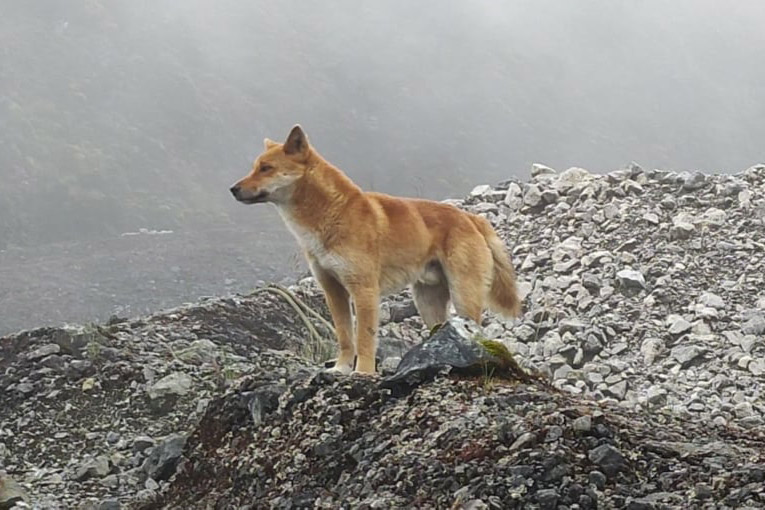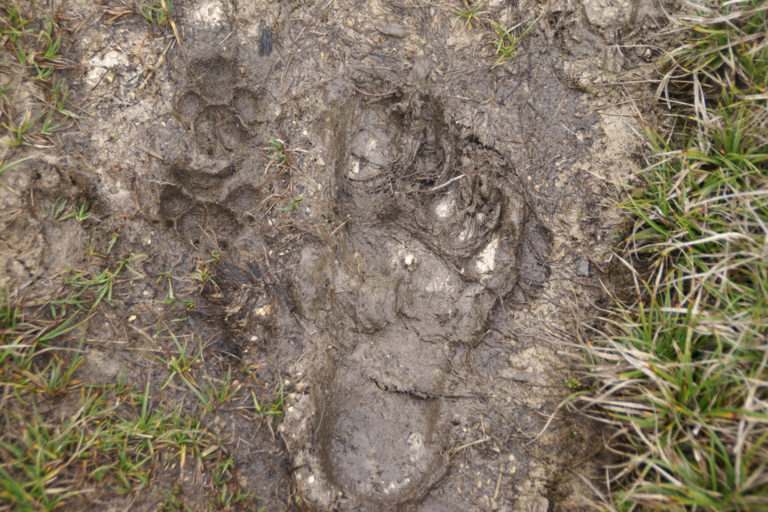- DNA analysis of three wild dogs living at high altitude on New Guinea reveals that they are part of the same population as captive New Guinea singing dogs.
- These findings confirm that New Guinea singing dogs are not extinct in the wild as previously thought.
- New conservation methods are now being considered to protect what some consider to be the world’s rarest wild dog.
An analysis of the DNA of three wild dogs living above 4,300 meters (14,000 feet) on the island of New Guinea matches that of captive New Guinea singing dogs. These findings show that the New Guinea singing dog is not extinct in the wild, as most zoologists had assumed, researchers reported recently in the Proceedings of the National Academy of Sciences.
New Guinea singing dogs are best known for their haunting and unique vocalizations, which sound like a cross between a wolf’s howl and whale song. The dogs are not listed as threatened by the IUCN, as the organization considers them to be a breed of domestic dog (Canis familiaris). The authors of the paper argue that these dogs are genetically and behaviorally distinct from their domestic cousins. “They are a kind of proto-domestic dog,” said study co-author James McIntyre. “[They have] remained frozen in time.”
Wildlife biologists had thought that New Guinea singing dogs went extinct in the wild sometime in the 1970s. A couple hundred of the animals linger on in zoos and as exotic pets. But the entire captive population has expanded from just eight original dogs, so the descendants are highly inbred. Without genetic diversity, these remnant dogs risk becoming infertile.

But in 2012, an ecotourist guide snapped a picture of what appeared to be a New Guinea singing dog in a remote and mountainous part of New Guinea. The picture eventually landed in the hands of McIntyre, the field director of a conservation foundation that has searched for a wild population of the singing dogs since 1996.
The picture provided a lead. So in 2016, McIntyre headed to where it was taken, near the high Grasberg mine, one of the largest gold mines in the world. In these mountains, McIntyre set up trail cameras at the bases of glaciers. Aside from some lonely pawprints, there were no signs of any dogs until the last day of the study, when a pack walked by the cameras. They looked similar to captive singing dogs, but McIntyre knew scientists would require DNA evidence to prove they were the same breed.
In 2018, he returned with traps. McIntyre collected blood from two male dogs and attached GPS collars before releasing them. The team also collected samples from a dead female dog found alongside the road on the outskirts of the mine. McIntyre loaded up the samples and traveled back to the U.S., where he handed them over to geneticist Elaine Ostrander at the National Human Genome Research Institute in Bethesda, Maryland.
“That was my carry-on,” said McIntyre. “I didn’t care about anything else. But those samples, I had to know where they were at all times.”


Ostrander and her group compared the DNA of the three dogs to that of animals from four groups: dingoes, domestic breeds, village dogs from around the Grasberg mine, and captive New Guinea singing dogs. Their results demonstrated that the samples came from a genetically diverse population of New Guinea singing dogs—proving that this population is still alive in the wild.
The team’s publication was led by first author Suriani Surbakti, a biologist at Cenderawasih University in Jayapura, Indonesia. Authors included five of Surbakti’s colleagues there, as well as researchers from Wales, Germany, and Australia.
Some scientists dispute the premise of the research. Kristofer Helgen, chief scientist and director at the Australian Museum Research Institute in Sydney, reported finding wild dog feces during one of his field expeditions to New Guinea in 2007. Helgen told Mongabay that singing dogs are widespread and are not considered extinct by field biologists working in New Guinea.
McIntyre disagrees with this evaluation and considers the genetic results definitive. The researchers hope that their findings will push international organizations and the Indonesian government to protect New Guinea singing dogs in the wild.
Their vocal signatures alone have great value, said Ostrander: “That’s not something we want to lose from the planet.”

Citation:
Surbakti, S., Parker, H. G., McIntyre, J. K., Maury, H. K., Cairns, K. M., Selvig, M., Pangau-Adam, M., Safonpo, A., Numberi, L., Runtuboi, D. Y. P., Davis, B.W., Ostrander, E. A. (2020) New Guinea highland wild dogs are the original New Guinea singing dogs Proceedings of the National Academy of Sciences, 117 (39). doi:10.1073/pnas.2007242117
Freda Kreier (@FKreier) is a graduate student in the Science Communication Program at the University of California, Santa Cruz. Other Mongabay stories produced by UCSC students can be found here.













